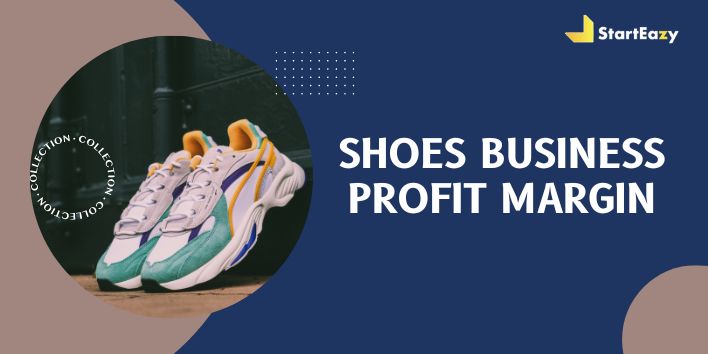Shoes Business Profit Margin | Guide for Startups

Shoe businesses offer great money-making potential. However, the profitability depends on the kind of footwear they stock, their pricing plans and marketing strategies. Considering all variables, the estimated shoes business profit margin is 20% - 40% approximate.
Overview of Shoe Business in India
- Investment: Rs. 15 Lacs - Rs. 20 Lacs (minimum)
- Area Required: 300 sq ft. - 800 sq ft. (minimum)
- Human Resource: 3 - 5 People (initially)
- Shoes Business Profit Margin: 20% - 40%
- Estimated Sales: Rs.40,000 - Rs.60,000 per month
How to Determine the Profit Margin in Shoes Business?
The profit margin of a shoe business is typically measured as a percentage of total sales.
However, they can vary greatly depending on:
- Type of Shoe Business
- Production Costs
- Marketing Costs
- Overhead Expenses
Profit Margin in Different Type of Shoe Business
Different types of shoe businesses have different cost structures and thus, different profit margins.
For example, a retail shoe store has a profit margin of approximately 20% - 30%.
Whereas, a wholesale shoe distributor has a profit margin of approximately 35% due to the lower cost of goods sold.
Likewise, an online shoe store has a profit margin of approximately 27% - 32%.
Whereas, a brick-and-mortar store has a profit margin of 15% - 20% due to a smaller customer base.
Understanding your profit margin is also important for setting realistic goals for your business.
It also helps you in making informed decisions about pricing, inventory, and other aspects of running a successful shoe business.
Minimum Investment Required to Start a Shoe Business
Starting a shoe business requires a significant amount of investment. The exact amount depends on the size and scope of the business.
But, in general, it is safe to say that you need at least Rs. 10 Lacs to get started.
This investment will be used for renting a space, buying inventory, business registration, GST registration, hiring staff and marketing your product.
You can use online platforms like Amazon or Flipkart to launch your store without any upfront costs.
Additionally, you can also look for investors who are willing to fund your venture in exchange for equity in the company. You can find these investors on platforms like Kickstarter, SMERGERS, FuelADream, etc.
Moreover, you can also consider the following funding sources:
- Business Loans
- Private Equity Loans
- Government Schemes for Startups
- Borrowing for Friends and Family
- Personal Savings
With careful planning and budgeting, it is possible to start a successful shoe business with minimal investment.
Minimum Area Required to Start a Shoe Business
Starting a shoe business requires a certain amount of space to store and display your products.
The minimum area required to start a shoe business depends on the type of business you want to open, the number of products you plan to stock, and the target market you are aiming for.
For example, if you are looking to open a small boutique specializing in designer shoes, you may need around 200 square feet of space for display racks and storage shelves.
On the other hand, if you are opening a larger store that will carry multiple brands and styles of shoes, then you may need up to 1,000 square feet or more.
No matter what kind of shoe business you plan on starting, it is important to make sure that your chosen space is large enough. So the customers can easily browse through your selection without feeling cramped or crowded.
Human Resource Required to Start a Shoe Business
Having the right team of people will help you manage the day-to-day operations and marketing of your business.
You must hire people who have some knowledge about the latest trends in shoes to ensure that your store offers products that customers will love.
With their help, you can create an amazing shopping experience for your customers that will keep them coming back for more!
Here is a list of people you will need, along with the average salaries :
- 2-3 Store Helpers - Rs.6,000 - Rs.10,000 (Per Month Per Employee)
- Accountant - Rs. 20,000 - Rs. 25,000 (Per Month Per Employee)
- Store Manager - Rs. 18,000 - Rs.24,000 (Per Month Per Employee)
- Security Guard - Rs. 8,000 - Rs 10,000 (Per Month Per Employee)
This will help you prepare a minimum budget for the salaries per month.
You can hire an accountant and store manager by looking up job portals online like Naukri.
For store helpers and security guards, it is advisable to hire through your personal network.
3 Tips to Improve Your Shoes Business's Profit Margin
Achieving a higher profit margin requires a combination of tactics, from setting the right prices for your products to finding cost-effective ways to produce them.
Create An Effective Pricing Strategy
As a shoe business, it is important to have an effective pricing strategy in order to maximize your profit margin.
With the right pricing strategy, you can ensure that you are making the most out of every sale.
Therefore, understand the market, consider customer needs and preferences, and determine the costs of production before setting a price.
Average Shoe Prices in India
|
Shoe Type |
Local Shoes |
Branded Shoes |
|
Casual Shoes |
Rs.400 – Rs.999 |
Rs.2000 – Rs.10000 |
|
Athletic Shoes |
Rs.500 – Rs.1500 |
Rs.4000 – Rs.12000 |
|
Formal Shoes |
Rs.500 – Rs.2000 |
Rs.1800 – Rs.8000 |
|
Loafers |
Rs.600 – Rs.1000 |
Rs.1500 – Rs.6000 |
|
Walking Shoes |
Rs.300 – Rs.700 |
Rs.1299 – Rs.4000 |
|
Customized |
- |
Starts from Rs.10000 |
You can use the above data to decide the prices of your shoes. If you want to go for the brand prices, you must apply for trademark registration online.
Leverage Digital Marketing
By leveraging digital marketing, businesses can reach a larger audience and target potential customers more effectively.
For shoe businesses, digital marketing can be used to create a successful online presence and increase brand awareness.
You must create a separate business account on social media platforms like Instagram, Facebook and WhatsApp.
On these pages, you can post product pictures and discount offers to attract potential customers.
Optimize your Inventory
Having the right inventory can make or break your shoe business's success.
Optimizing your inventory is key to maximizing profits and improving your business's bottom line.
It involves analyzing what products you have in stock, when to restock, and how much of a product to keep on hand.
By understanding the ins and outs of inventory optimization, you can make sure that your shoe business is always stocked with the right items at the right time to maximize profits and minimize losses.








